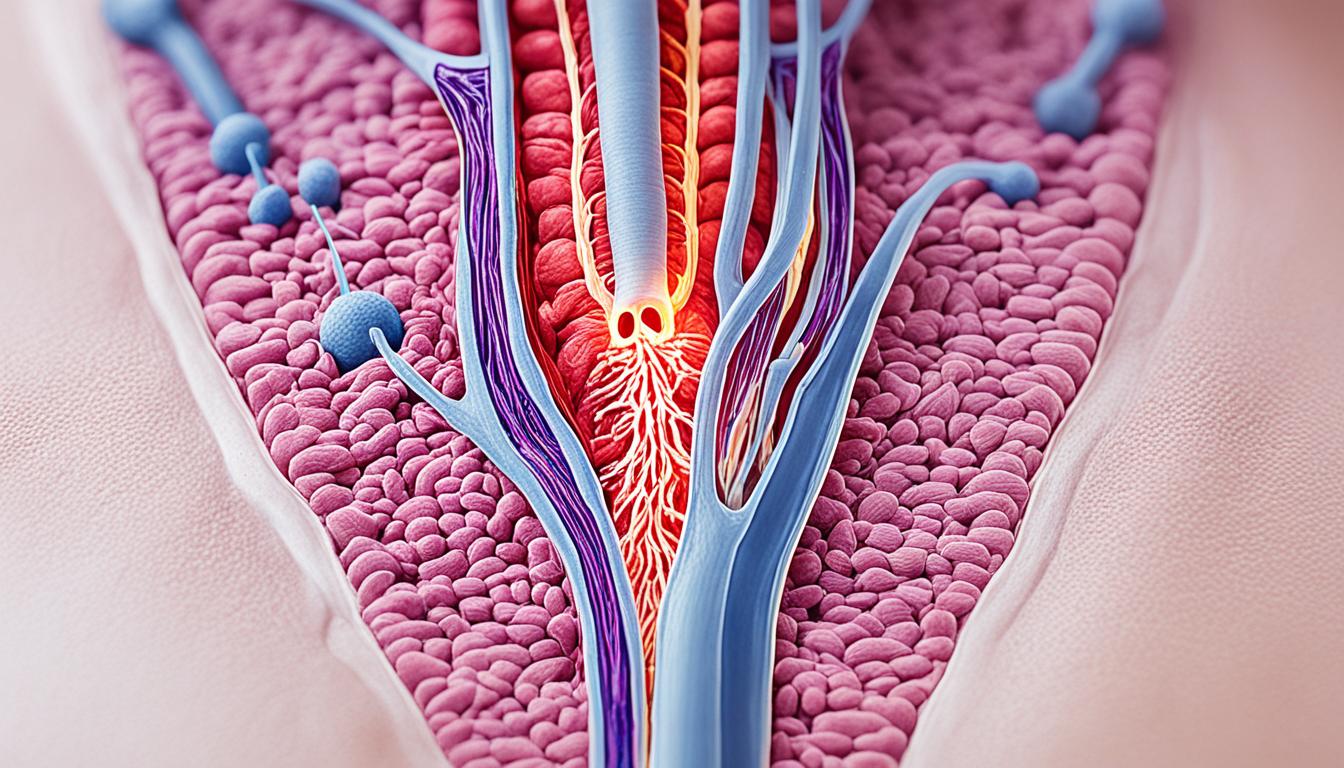Hypoparathyroidism is a rare parathyroid disorder. It’s marked by low PTH levels, causing low blood calcium levels. This can happen due to surgery, autoimmune issues, and genetic problems. In the U.S., there are 37 cases per 100,000 person-years. In Denmark, it’s around 22 cases per 100,000 person-years. This makes hypoparathyroidism a tough issue for both patients and healthcare providers.
Hypoparathyroidism leads to low calcium levels. This can cause muscle cramps, tingling, fatigue, and more. To treat it right, doctors must first make sure it’s really hypoparathyroidism. They do this by checking PTH levels and looking at the different possible causes.
Today, the main treatment is taking extra calcium and vitamin D. But, there’s hope for new ways, like stem cell therapy. This approach means putting new parathyroid cells into the body. These cells help produce the missing hormones. Still, we need more studies to make sure this method is safe and works well.
Key Takeaways:
- Hypoparathyroidism is a rare parathyroid disorder characterized by low levels of parathyroid hormone (PTH) and low calcium levels in the blood.
- Causes of hypoparathyroidism include surgical removal of the parathyroid glands, autoimmune disorders, and genetic disorders.
- Common symptoms include muscle cramps, tingling or numbness in the extremities, fatigue, and complications such as renal insufficiency, kidney stones, cataracts, and intracerebral calcifications.
- Accurate diagnosis of hypoparathyroidism involves measuring PTH levels and differentiating between different causes.
- Treatment options include calcium and vitamin D supplementation, with emerging research exploring the potential of stem cell therapy.
Symptoms and Diagnosis of Hypoparathyroidism
Hypoparathyroidism is a complex condition that shows various symptoms. These are all tied to low calcium in the blood. It’s key to spot these symptoms and do the right tests for an early diagnosis.
Symptoms of Hypoparathyroidism
The signs of hypoparathyroidism can change from one person to another. But, common ones are:
- Muscle cramps
- Tingling or numbness in the extremities
- Fatigue
- Mood changes
These signs happen because the blood has too little calcium. They can really lower someone’s life quality.
Diagnosis of Hypoparathyroidism
To diagnose hypoparathyroidism, doctors look at symptoms and do tests.
They first review the patient’s health history and symptoms, and do a physical check. But, to confirm, they need to measure blood calcium, phosphate, and PTH levels well.
Knowing PTH levels is key for hypoparathyroidism’s diagnosis. The recent tests are accurate. They really help separate hypoparathyroidism from other issues.
Doing more tests, like checking genes, may also be needed. This can show if the condition is due to genes or not.
| Hypoparathyroidism Diagnostic Tests | Description |
|---|---|
| Calcium and Phosphate Measurement | Measuring the levels of calcium and phosphate in the blood is crucial for diagnosing hypoparathyroidism. |
| PTH Measurement | Accurately measuring PTH levels helps confirm the diagnosis of hypoparathyroidism and differentiate it from other conditions. |
| Genetic Testing | Genetic testing may be necessary to identify the underlying cause of hypoparathyroidism and determine if it is hereditary or acquired. |
With these tests, doctors can diagnose hypoparathyroidism well. This leads to a good plan for treatment.
Treatment and Management Strategies for Hypoparathyroidism
The main goal in treating hypoparathyroidism is to manage low calcium and prevent symptoms. Treatments include calcium supplements, vitamin D analogs, and sometimes stem cell therapy. Other strategies also help in managing the condition.
Calcium Supplementation
Most often, calcium supplements are the first step. They boost and maintain blood calcium levels. Two common types are calcium carbonate and calcium citrate. Dosage is customized and taken in several small doses daily.
Vitamin D Analogs
Vitamin D is crucial for calcium to be absorbed. In this condition, analogs like calcitriol are used. These work to better absorb calcium from foods and from the kidneys. Dosing and how often it’s taken are closely watched based on what each patient needs.
Stem Cell Therapy
Stem cell therapy is an area of new hope for hypoparathyroidism. It includes transplanting engineered parathyroid cells. The aim is to make natural PTH (parathyroid hormone) and control calcium levels. This method shows promise but needs more studies to confirm its benefits and safety.
Management Strategies
Other key strategies include:
- Keep a check on calcium and phosphate levels to stay within healthy ranges
- Eat a diet packed with calcium and vitamin D
- Avoid food and drugs that hinder calcium absorption, like high-fiber foods and some antacids
- Treat complications that may arise, like kidney stones, early and suitably
By using these and other strategies, doctors can customize a care plan for each person with hypoparathyroidism. The aim is to manage the condition well, lessen symptoms, and avoid further health issues.
| Treatment Options | Description |
|---|---|
| Calcium Supplementation | Provides additional calcium to raise and maintain calcium levels in the blood |
| Vitamin D Analogs | Enhances calcium absorption by mimicking the actions of active vitamin D |
| Stem Cell Therapy | Transplantation of bioengineered parathyroid cells to restore normal parathyroid function |
Conclusion
Hypoparathyroidism is a rare disorder where the body has too little parathyroid hormone. This causes low calcium levels. It can be caused by surgery, autoimmunity, or genetics. Doctors must check the levels of calcium, phosphate, and parathyroid hormone to diagnose it.
Treating this disorder often means taking extra calcium and vitamin D. But, new treatments like stem cell therapy show a lot of promise. They could help the body work on its own again, fixing the cause of the low hormone levels.
Healthcare providers need to know a lot about how to spot, diagnose, and treat hypoparathyroidism. We also need more research to make caring for patients better. Looking into treatments like stem cells could really change things for the better in the years to come.

